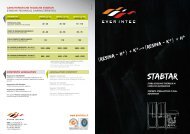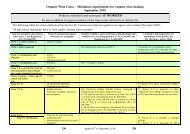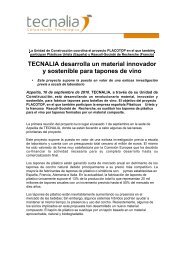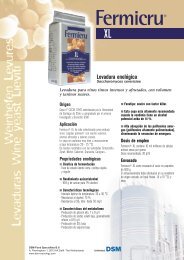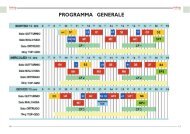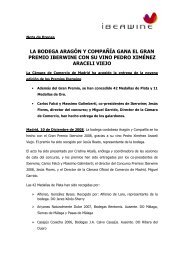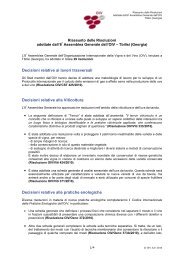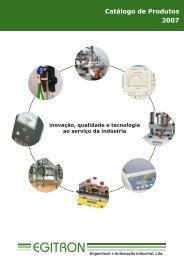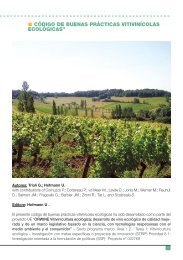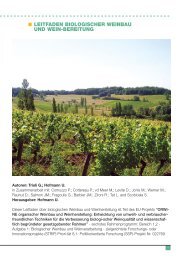- Page 1 and 2:
“CODICE DI BUONE PRATICHE PER LA
- Page 3 and 4:
LA PARTNERSHIP DI ORWINE Uwe Hofman
- Page 5 and 6:
RINGRAZIAMENTI Gli autori ringrazia
- Page 7 and 8:
INDICE DEFINIZIONE DI VINO BIOLOGIC
- Page 9 and 10:
PREFAZIONE Quando questa pubblicazi
- Page 11 and 12:
ficati (OGM) così come di additivi
- Page 13 and 14:
di per sé, non è un manuale HACCP
- Page 15 and 16:
1. Clima semiarido - subtropicale s
- Page 17 and 18:
HACCP 1 - CONCETTI DI VITICOLTURA B
- Page 19 and 20:
l’ottenimento di un prodotto fina
- Page 21 and 22:
1. VITICOLTURA BIOLOGICA (Hofmann,U
- Page 23 and 24:
Struttura del terreno e sostanza or
- Page 25 and 26:
Differenti condizioni del suolo e d
- Page 27 and 28:
La diversificazione delle piante è
- Page 29 and 30:
Gestione delle colture di copertura
- Page 31 and 32:
Fig. 9: Differenti opzioni tecniche
- Page 33 and 34:
• Minerali derivanti da fonti nat
- Page 35 and 36:
Varietà White Grapes Peronospora P
- Page 37 and 38:
Varietà Uva rossa Montepulciano, U
- Page 39 and 40:
Fonte: PIWI-international (http://w
- Page 41 and 42:
Fig. 13: Differenti sistemi di alle
- Page 43 and 44:
Fig. 15: Differenti sistemi di alle
- Page 45 and 46:
1.3. Protezione delle piante In vit
- Page 47 and 48:
Nelle aree colpite più frequenteme
- Page 49 and 50:
Fig. 21: Infezione fogliare da pero
- Page 51 and 52:
Strategie per la protezione delle p
- Page 53 and 54:
Controllo Misure di controllo indir
- Page 55 and 56:
1.3.1.3. Botrytis cinerea - muffa g
- Page 57 and 58:
Strategie per la protezione delle p
- Page 59 and 60:
Fig. 28: Trappole con ferormoni e c
- Page 61 and 62:
1.3.2.2. Ragni - Acari (Panonychus
- Page 63 and 64:
1.3.2.3. Cicadellidae (Empoasca vit
- Page 65 and 66:
Strategie di protezione delle piant
- Page 67 and 68:
2. PRODUZIONE DI VINO BIOLOGICO 2.1
- Page 69 and 70:
I grappoli di uva Bianca possono es
- Page 71 and 72:
Principi generali Lo stato di salut
- Page 73 and 74:
spatura senza pigiatura, uso di pom
- Page 75 and 76:
2.1.3.4. Estrazione dei costituenti
- Page 77 and 78:
Fig. 41: Moderne presse pneumatiche
- Page 79 and 80:
Fig. 43: Vinificazione in bianco -
- Page 81 and 82:
2.1.4.2. Riduzione del contenuto di
- Page 83 and 84:
2.1.4.4. Eliminazione delle protein
- Page 85 and 86:
2.1.4.6. Mezzi di Separazione dei t
- Page 87 and 88:
Pratiche di vinificazione Decantazi
- Page 89 and 90:
co. Quando la degradazione biologic
- Page 91 and 92:
2.1.5.1. Avvio della fermentazione
- Page 93 and 94:
2.1.5.2. Gestione dell’azoto Prin
- Page 95 and 96:
Pratiche di vinificazione Enologia
- Page 97 and 98:
Nelle produzioni biologiche, il mos
- Page 99 and 100:
La crescita incontrollata di batter
- Page 101 and 102:
La perdita di qualità può essere
- Page 103 and 104:
te, che non è stato eliminato in p
- Page 105 and 106:
dei fenoli, avviene utilizzando gen
- Page 107 and 108:
2.1.7.3. Stabilizzazione tartarica
- Page 109 and 110:
2.1.8. Filtrazione e imbottigliamen
- Page 111 and 112:
Fig. 50: Filtrazione tangenziale Fi
- Page 113 and 114:
2.1.8.3.Imbottigliamento Principi I
- Page 115 and 116:
seconda del polimero plastico e del
- Page 117 and 118:
La vinificazione di vini biologici
- Page 119 and 120:
2.2.3.1. Aggiunte di conservantI Pr
- Page 121 and 122:
Fig. 62: Tini di fermentazione per
- Page 123 and 124:
conseguente estrazione e aumento si
- Page 125 and 126:
ifica. L’aggiunta di enzimi pecto
- Page 127 and 128:
2.2.4.1. Inizio della fermentazione
- Page 129 and 130:
2.2.4.2. Gestione dell’azoto Prin
- Page 131 and 132:
2.2.4.4. Arricchimenti Principi L
- Page 133 and 134:
2.2.5. Macerazione Fig. 67: Vini ro
- Page 135 and 136:
Pratiche di vinificazione Estesa La
- Page 137 and 138:
2.2.5.3. Gestione dell’estrazione
- Page 139 and 140:
2.2.5.4. Serbatoi di macerazione Pr
- Page 141 and 142:
2.2.5.5. Torchiatura della vinaccia
- Page 143 and 144:
2.2.6.1. Fermentazione Malolattica
- Page 145 and 146:
2.2.6.3. Contatto con le fecce Prin
- Page 147 and 148:
2.2.6.5. Affinamento in legno Princ
- Page 149 and 150:
2.2.7. Chiarifiche e Stabilizzazion
- Page 151 and 152:
2.2.7.2. Stabilizzazione della fraz
- Page 153 and 154: 2.2.7.4. Coadiuvanti di chiarifica
- Page 155 and 156: 2.2.8.1. Filtrazione sgrossante Pri
- Page 157 and 158: 2.2.8.3. Aggiunta di conservanti Pr
- Page 159 and 160: Fig. 78: Imbottigliatrice per picco
- Page 161 and 162: Bibliografia: Adams, D. O. and Liya
- Page 163 and 164: Suzzi, G. and Romano, P. (1982) Ind
- Page 165 and 166: • Normativa esistente: Conformit
- Page 167 and 168: Indipendentemente dal tipo di sporc
- Page 169 and 170: Trattamento del mosto: Quando si vu
- Page 171 and 172: di questo additivo. La parte di SO
- Page 173 and 174: Quando la fermentazione è condotta
- Page 175 and 176: Tiamina: Si raccomanda l’aggiunta
- Page 177 and 178: Temperatura Questa variabile influe
- Page 179 and 180: Reazione dell’ossigeno nei vini A
- Page 181 and 182: acetico e poi in etil acetato, comp
- Page 183 and 184: vengono tenuti sotto controllo ques
- Page 185 and 186: della maggior parte dei microrganis
- Page 187 and 188: Tabella 5: Singole fasi del process
- Page 189 and 190: Vantaggi: Con la stessa quantità d
- Page 191 and 192: Pinot Grigio indice di polifenoli t
- Page 193 and 194: Risultati principali I risultati co
- Page 195 and 196: 5.2. Iperossigenazione (Zironi, R.;
- Page 197 and 198: VCs: vinificazione convenzionale (3
- Page 199 and 200: H: scorze di lievito (400 mg/L) e t
- Page 201 and 202: Un altro importante motivo che port
- Page 203: SAUVIGNON (VINO FINITO - GENNAIO 07
- Page 207 and 208: 5.5. Influenza dei nutrienti sulla
- Page 209 and 210: 5.6. Tecnologie e pratiche di vinif
- Page 211 and 212: molto piccole (con aggiunta di 1g /
- Page 213 and 214: Non ci sono state differenze signif
- Page 215 and 216: Tabella 15: Risultati dell’inocul
- Page 217 and 218: Risultati e Conclusioni Il primo es
- Page 219 and 220: 5.8. Valutazione Ambientale (Capri,
- Page 221 and 222: Tabella 16: Il test in azienda. Som
- Page 223 and 224: 6. PROTOCOLLI DI LAVORO (Zironi, R.
- Page 225 and 226: 2007 Protocollo A. IPEROSSIGENAZION
- Page 227 and 228: 2007 Protocollo C. PIED DE CUVE CON
- Page 229 and 230: 2007 Protocollo E. GESTIONE DELLE F
- Page 231 and 232: 2008 Protocollo A. PIED DE CUVE CON
- Page 233 and 234: 2008 Protocollo C. GESTIONE DELLE F
- Page 235 and 236: 2008 Protocollo E. CO-INOCULO DI LI




